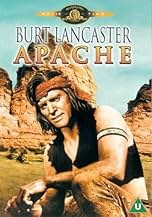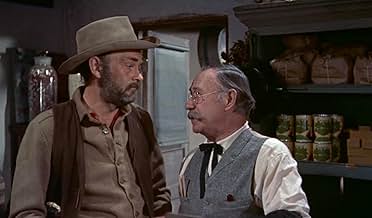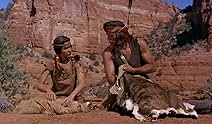NOTE IMDb
6,3/10
5,3 k
MA NOTE
Ajouter une intrigue dans votre langueRefusing to let himself be re-settled on a Florida reservation, Massai, an Apache warrior, escapes his captors and returns to his homeland to become a peaceful farmer.Refusing to let himself be re-settled on a Florida reservation, Massai, an Apache warrior, escapes his captors and returns to his homeland to become a peaceful farmer.Refusing to let himself be re-settled on a Florida reservation, Massai, an Apache warrior, escapes his captors and returns to his homeland to become a peaceful farmer.
- Réalisation
- Scénario
- Casting principal
Charles Bronson
- Hondo
- (as Charles Buchinsky)
Dehl Berti
- Cherokee Householder
- (non crédité)
Paul E. Burns
- General Store Proprietor
- (non crédité)
Lonnie Burr
- Indian Boy
- (non crédité)
Jerado Decordovier
- Apache
- (non crédité)
John George
- Shoeshine Man
- (non crédité)
Anne Kunde
- Townswoman Leaving Trading Post
- (non crédité)
Rory Mallinson
- Citizen Noticing Handcuffs
- (non crédité)
Mort Mills
- Sergeant of the Guard Fort.
- (non crédité)
Avis à la une
RELEASED IN 1954 and directed by Robert Aldrich, "Apache" is based on the real-life story of Massai (Burt Lancaster), a Chiricahua Apache who was exiled with other Apaches to a reservation in Florida to be held with Geronimo and Chihuahua, but he escapes the train somewhere near St. Louis and travels 1200 miles back to the Mescalero Apache tribal area, conducting one-man raids near what is now the Arizona-New Mexican border. John McIntire plays the chief of scouts commissioned to capture Massai while Charles Bronson (Buchinsky) is on hand as an Apache scout. Jean Peters plays an Apache babe who, in real life, was Zanagoliche.
Massai actually escaped the prison train with a Tonkawa Native named Gray Lizard and they traveled the long journey back by foot together, eventually parting company in Southeastern Arizona. Gray Lizard is, unfortunately, completely omitted in the film.
To enjoy this movie you have to look past Lancaster in the lead role or, at least, imagine him to look more like a real Apache. But, keep this in mind: Since Massai is the sympathetic protagonist of the story the movie would've never been made in the early 50s without a known Hollywood star playing the role. Why? Simple: Producers needed to attract viewers in order for the film to make money. Actually, Lancaster isn't too unbelievable in the role, as long as you can disregard his blue eyes. Unfortunately babelicious Peters looks way too European to play an Apache squaw, even though they tried to hide it by darkening her skin. On the positive side, there are a lot of real Natives in peripheral roles.
The whole first act is great as Massai is a fish-out-of-water in the city of St. Louis. Unfortunately there are dull stretches in the second and third acts. Nevertheless, "Apache" was better than I thought it would be and inspired me to look up the real-life Massai. It was also a hit at the box office despite falling into relative obscurity since then. The score is surprisingly bearable for an old Western.
"Apache" made Native Americans (who aren't really 'native' since their ancestors emigrated from Asia) sympathetic characters in cinema, along with earlier Westerns, like "Buffalo Bill" (1944), "Fort Apache" (1948) and "Broken Arrow" (1950) and later Westerns, like "The Last Wagon" (1956), "A Man Called Horse" (1970) and "I Will Fight No More Forever" (1975).
THE FILM RUNS 1 hours & 31 minutes and was shot in California, Arizona and New Mexico. WRITERS: James R. Webb wrote the script based on Paul Wellman's novel.
GRADE: B-
Massai actually escaped the prison train with a Tonkawa Native named Gray Lizard and they traveled the long journey back by foot together, eventually parting company in Southeastern Arizona. Gray Lizard is, unfortunately, completely omitted in the film.
To enjoy this movie you have to look past Lancaster in the lead role or, at least, imagine him to look more like a real Apache. But, keep this in mind: Since Massai is the sympathetic protagonist of the story the movie would've never been made in the early 50s without a known Hollywood star playing the role. Why? Simple: Producers needed to attract viewers in order for the film to make money. Actually, Lancaster isn't too unbelievable in the role, as long as you can disregard his blue eyes. Unfortunately babelicious Peters looks way too European to play an Apache squaw, even though they tried to hide it by darkening her skin. On the positive side, there are a lot of real Natives in peripheral roles.
The whole first act is great as Massai is a fish-out-of-water in the city of St. Louis. Unfortunately there are dull stretches in the second and third acts. Nevertheless, "Apache" was better than I thought it would be and inspired me to look up the real-life Massai. It was also a hit at the box office despite falling into relative obscurity since then. The score is surprisingly bearable for an old Western.
"Apache" made Native Americans (who aren't really 'native' since their ancestors emigrated from Asia) sympathetic characters in cinema, along with earlier Westerns, like "Buffalo Bill" (1944), "Fort Apache" (1948) and "Broken Arrow" (1950) and later Westerns, like "The Last Wagon" (1956), "A Man Called Horse" (1970) and "I Will Fight No More Forever" (1975).
THE FILM RUNS 1 hours & 31 minutes and was shot in California, Arizona and New Mexico. WRITERS: James R. Webb wrote the script based on Paul Wellman's novel.
GRADE: B-
Apache was the third feature Robert Aldrich directed. Before he worked as an assistant director to Jean Renoir, William Wellman, Lewis Milestone and even Charlie Chaplin and also made several episodes for TV films. He was invited to direct Apache by its co-producer and main star Burt Lancaster.
The Apache's particularity is that it doesn't enter the classic Western scheme of almost obligatory showing of the Indians as bad guys, thou the most illustrious example of this probably belong to John Ford's 1964 Cheyenne Autumn with which the legendary director bid a farewell to the genre. Also Apache's distinctiveness resides in the treatment that is given to the central theme of the Western genre, which is revenge.
Here the Indian rebellious warrior Massai, wonderfully played by Burt Lancaster is obsessively seeking revenge facing the enemy not only in a form of one person or a small group of people in accordance with traditional Western vengeance system, but in a form an entire society either Indian or White, a society that he considers his enemy and against which he courageously fights alone not looking for help from anyone till he meets an equally strong character Nalinle (Jean Peters), a woman who simply accepts him as he is ready to share all the difficulties of Massai's life and even to sacrifice her own life for the man she loves. From this point on as his affection for Nalinle increases, his desire to fight everything and everyone proportionally decreases resulting in his settling down looking for more peaceful existence, which is hardly possible due to the burden of his past deeds which weighs over him personified in a collective figure of the American authorities who unceasingly continue to hunt him down.
A weak, but also in many ways remarkable Western featuring convincing performances from Burt Lancaster and Jean Peters in a tale of self-sacrificing love and courageous but ultimately pointless fight for imaginary cause. 7/10
The Apache's particularity is that it doesn't enter the classic Western scheme of almost obligatory showing of the Indians as bad guys, thou the most illustrious example of this probably belong to John Ford's 1964 Cheyenne Autumn with which the legendary director bid a farewell to the genre. Also Apache's distinctiveness resides in the treatment that is given to the central theme of the Western genre, which is revenge.
Here the Indian rebellious warrior Massai, wonderfully played by Burt Lancaster is obsessively seeking revenge facing the enemy not only in a form of one person or a small group of people in accordance with traditional Western vengeance system, but in a form an entire society either Indian or White, a society that he considers his enemy and against which he courageously fights alone not looking for help from anyone till he meets an equally strong character Nalinle (Jean Peters), a woman who simply accepts him as he is ready to share all the difficulties of Massai's life and even to sacrifice her own life for the man she loves. From this point on as his affection for Nalinle increases, his desire to fight everything and everyone proportionally decreases resulting in his settling down looking for more peaceful existence, which is hardly possible due to the burden of his past deeds which weighs over him personified in a collective figure of the American authorities who unceasingly continue to hunt him down.
A weak, but also in many ways remarkable Western featuring convincing performances from Burt Lancaster and Jean Peters in a tale of self-sacrificing love and courageous but ultimately pointless fight for imaginary cause. 7/10
Apart from Burt Lancaster's macho warrior performance, this movie is also saved by Robert Aldrich's direction. It's not brilliant in any sense, but pure enough to tell a story with some unique moments that give it his trade mark. Also the subject matter of an Indian being a hero was not common in the 1950s. It was a brave attempt to create empathy for the Indian Warrior, but it was not difficult because Burt Lancaster played it perfectly in a heroic campy style. I know, white folks playing Indigenous roles can sometimes put you off, but because of the time period it was made in, I decided to let it go and enjoy this Western romp because Lancaster is my all time favorite actors, and I was always interested in Aldrich as an accomplish director who had his own style that suited this film to perfection.
I grew up watching westerns so in turn love them dearly....they tie me in with a great childhood when things were simple and life was good in an unadulterated sense.
Burt Lancaster has always been a prominent actor and his talent is so very showing in this movie. Charles Bronson is also in the movie and comes across very well as a young actor who is later destined to be one of the greatest actors of our time. I thoroughly enjoyed watching this movie on a lazy Saturday afternoon and I highly recommend it for its soothing effects of a simple yesteryear long gone except in cinema.
It is a typical plot of indians being pushed out and destroyed by the Union Army with one stand out rebel.....hell bent with an anger created thru intense hate, yet capable of showing love towards the woman in his life.
Burt Lancaster has always been a prominent actor and his talent is so very showing in this movie. Charles Bronson is also in the movie and comes across very well as a young actor who is later destined to be one of the greatest actors of our time. I thoroughly enjoyed watching this movie on a lazy Saturday afternoon and I highly recommend it for its soothing effects of a simple yesteryear long gone except in cinema.
It is a typical plot of indians being pushed out and destroyed by the Union Army with one stand out rebel.....hell bent with an anger created thru intense hate, yet capable of showing love towards the woman in his life.
The movie tells the story of a rebellious apache who refuses to surrender with his chief Geronimo,and wages a one-man war against the U.S. cavalry.
Following movies like "Broken Arrow (1950)" this film takes the side of the Indian.Lancaster is again at his most athletic in the leading role,but he makes a rather unlikely Indian.The same could be said of Jean Peters,who nevertheless looks ravishing as Lancaster's squaw.It's anyway an entertaining movie.
Following movies like "Broken Arrow (1950)" this film takes the side of the Indian.Lancaster is again at his most athletic in the leading role,but he makes a rather unlikely Indian.The same could be said of Jean Peters,who nevertheless looks ravishing as Lancaster's squaw.It's anyway an entertaining movie.
Le saviez-vous
- AnecdotesMassai was born to Little Sun and White Shadow at Mescal Mountain, Arizona, near Globe. He later met Geronimo, who was recruiting Apaches to fight American soldiers. He also knew the Apache Kid. The policy in Arizona at the time was to exterminate hostile Apaches. Many Apache warriors fought for their people and traditions, fleeing and waging effective guerrilla warfare against their enemies.
Massai escaped over the border to Mexico, eventually settling in the Sierra Madre mountains in Sonora Mexico with a camp of rebellious Chiricahuas who had refused to surrender with Geronimo. Nothing is known of his final days.
- GaffesAbout 16 minutes into the movie as Massai (Burt Lancaster) is fleeing from the white mob through a hotel corridor you can see an unlit electric 'EXIT' sign visible in the hallway at the top of the shot.
- Crédits fousOpening credits: This is the story of Massai, the last Apache warrior. It has been told and re-told until it has become one of the great legends of the Southwest. It began in 1886 with Geronimo's surrender.
- ConnexionsFeatured in Bearing Witness, Native American Voices in Hollywood (2024)
Meilleurs choix
Connectez-vous pour évaluer et suivre la liste de favoris afin de recevoir des recommandations personnalisées
- How long is Apache?Alimenté par Alexa
Détails
Box-office
- Budget
- 1 240 000 $US (estimé)
- Durée1 heure 31 minutes
- Rapport de forme
- 1.37 : 1
Contribuer à cette page
Suggérer une modification ou ajouter du contenu manquant

Lacune principale
By what name was Bronco Apache (1954) officially released in India in English?
Répondre




































